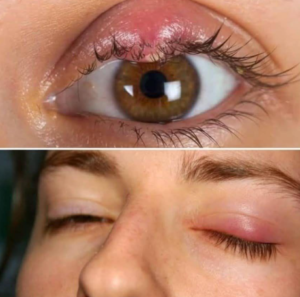A stye, or hordeolum, is a common eye condition that occurs when an oil gland in the eyelid becomes blocked and infected. These small, painful bumps usually develop near the edge of the eyelid, either on the upper or lower lid, and can appear red and swollen. They can also cause discomfort, itching, and sensitivity to light.
Causes of a Stye:
- Bacterial Infection: The most common cause of a stye is the infection of the oil glands in the eyelids by Staphylococcus bacteria. These bacteria are naturally found on the skin and can enter the gland through small openings, leading to inflammation and infection.
- Blocked Oil Glands: Each eyelash follicle contains an oil gland that produces a lubricant to keep the eyelids and eyes moist. When these glands become clogged by dead skin cells, oil, or dirt, the blockage can lead to infection and the formation of a stye.
- Poor Hygiene: Touching your eyes with unclean hands or rubbing the eyelids can transfer bacteria to the area, increasing the risk of infection. Additionally, using contaminated makeup, like mascara or eyeliner, can introduce bacteria to the eye, leading to a stye.
- Chronic Skin Conditions: People with conditions like rosacea or blepharitis (inflammation of the eyelid) are at an increased risk of developing styes. These conditions can cause inflammation and blocked glands in the eyelids, making them more susceptible to infection.
- Weakened Immune System: A compromised immune system, whether due to illness, medication, or other factors, can make it harder for the body to fight off infections, increasing the risk of styes.
Risks for Developing a Stye:
- Increased Stress: Stress can negatively affect the immune system, making it harder for the body to combat infections.
- Hormonal Changes: Hormonal changes, especially in women due to pregnancy or menstruation, can contribute to the development of styes by increasing oil production.
- Contact Lens Use: Wearing contact lenses without properly cleaning them or sharing lenses can introduce bacteria into the eye, leading to infections like styes.
- Aging: Older adults may have an increased risk due to changes in skin and eyelid function, which can make oil glands more prone to blockage.
How to Treat a Stye:
- Warm Compress: The most effective treatment for a stye is a warm compress. Applying a clean, warm cloth to the affected eyelid for 10-15 minutes several times a day can help soften the blocked gland and promote drainage, reducing pain and swelling.
- Clean the Area: Gently cleaning the eyelid with mild soap and water can help remove any dirt or oil that might be contributing to the blockage. Avoid squeezing or popping the stye, as this can worsen the infection.
- Antibiotic Ointment: Over-the-counter antibiotic ointments or drops may be prescribed by a healthcare provider to treat the infection. If the stye is particularly severe, oral antibiotics may be necessary.
- Avoid Makeup and Contact Lenses: During the healing process, it’s essential to avoid using eye makeup or contact lenses, as these can irritate the stye and introduce more bacteria.
- Pain Relievers: Over-the-counter pain relievers like ibuprofen or acetaminophen can help reduce pain and swelling associated with a stye.
Prevention Tips:
- Practice good hygiene by washing your hands frequently and avoiding touching your eyes.
- Clean makeup brushes regularly and avoid sharing makeup or contact lenses.
- Remove makeup thoroughly before bed, especially around the eyes.
If a stye doesn’t improve after a few days, becomes unusually painful, or causes vision problems, it’s important to see a healthcare provider for further evaluation and treatment.
